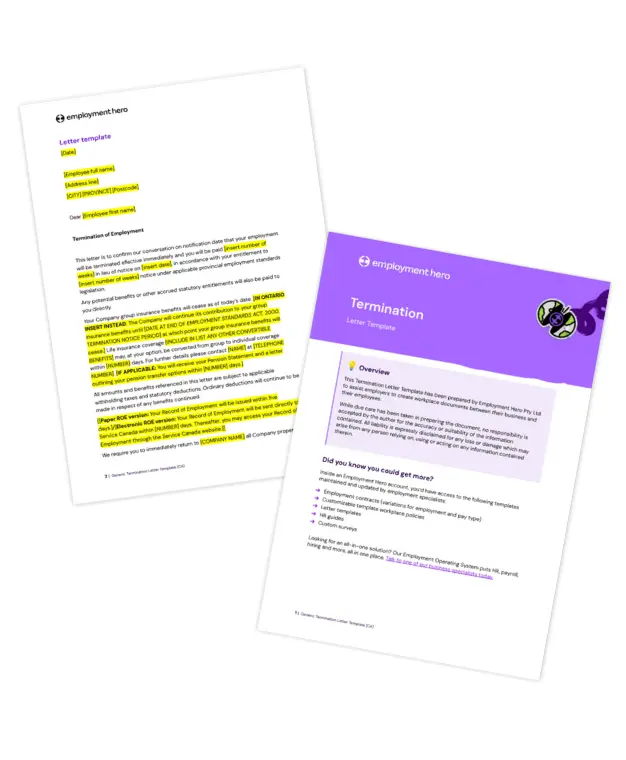Termination of employment letter template for employers
Published
Termination of employment letter template for employers
Published
Terminating an employee is never easy, but ensuring you handle the process with clarity and legal compliance is crucial for protecting your business. A termination letter serves as the official, formal record of the employment separation.
This guide provides a comprehensive overview of what a legally sound termination letter for employers must include in Canada. Most importantly, we offer a free, downloadable termination of employment letter template for Canadian employers, designed to help you communicate essential information clearly, professionally and in line with relevant provincial employment standards.

Understanding the importance of a clear and compliant termination letter
A well-crafted termination letter is more than just a formality; it’s an essential document that mitigates risk and ensures a professional separation.
Clarity and professionalism
A clear, concise letter removes ambiguity about the employee’s final day, compensation and post-employment obligations. It documents the terms of the separation, ensuring both parties have a shared understanding. Using a professional template demonstrates good faith and respect for the separating employee, which can help maintain your company’s reputation and reduce the likelihood of disputes.
Legal compliance and risk reduction
Labour laws, which often vary by province in Canada, dictate specific requirements for notice periods, severance and the handling of benefits. A compliant termination letter serves as evidence that your organization has met its statutory obligations. Failing to include required elements or sending a poorly worded letter, can expose your business to potential wrongful dismissal claims or costly legal actions. Our template is drafted to help you include all necessary information to meet Canadian standards.
What should employers include in a termination letter?
Every official termination letter must contain specific elements to be legally sound and professional. Here are the key components you must include:
1. Date of termination and effective date
Clearly state the date the letter is being issued and, most importantly, the effective date of the employment termination. This date is critical for calculating notice periods, final pay and the end of benefits.
2. Official statement of termination
Begin the body of the letter with a clear and unambiguous statement confirming the termination of employment. Keep the tone professional and direct.
3. Notice or pay in lieu of notice
Specify the employee’s entitlement to notice of termination, severance pay (if applicable) or pay in lieu of notice, as required by your provincial employment standards legislation. Clearly state the number of weeks being provided and the date the payment will be made.
4. Final pay and accrued entitlements
Detail the components of the employee’s final paycheck, which typically include wages earned up to the effective termination date, any outstanding vacation pay and other accrued statutory entitlements.
5. Employee benefits continuation or cessation
Clearly outline the status of the employee’s group insurance benefits (health, dental, life insurance, etc.). Specify the exact date when company contributions to these benefits will cease, adhering to provincial requirements. Include information on any convertible benefits, such as life insurance and the deadline for the employee to convert to an individual policy.
6. Record of Employment (ROE)
Inform the employee about their Record of Employment (ROE), which they will need to apply for Employment Insurance (EI). State whether the ROE will be issued in paper form or electronically and the timeframe for its submission (generally five days after the termination or the last day of the pay period).
7. Return of company property
List all company property that the employee is required to return immediately. This may include, but is not limited to, laptops, cellphones, keys, security passcards, company automobiles and any proprietary documents or data. Provide clear instructions for the return process.
8. Confidentiality and other post-employment obligations
If the employee is bound by confidentiality agreements, non-solicitation or non-competition clauses, briefly remind them of their ongoing obligations as per their original employment contract.
Download our free Termination Letter template
Save time and reduce the stress of drafting this sensitive document from scratch. Our termination of employment letter template is a clean, professionally formatted and customizable document designed for Canadian employers.
What the template includes:
- Ready-to-use sections for all the mandatory elements listed above.
- Customizable placeholders in brackets [] that guide you on where to insert specific employee, company and compensation details.
- Specific instructions for different provincial requirements (e.g., a note for Ontario employers regarding the continuation of benefits during the statutory notice period).
Using this template ensures you don’t miss any critical information, helping you maintain legal compliance and a professional separation process.h respect.

Termination letter examples
While our template provides a solid foundation, the exact wording and details will change depending on the circumstances of the termination.
Sample: Termination without cause (layoff/restructuring)
This example is for a situation where the termination is due to business reasons (like restructuring) and not the employee’s poor performance or misconduct.
| Element | Content |
|---|---|
| Official statement | This letter is to confirm our conversation today, [Date], that your employment with [Company Name] will be terminated effective immediately, due to a company-wide restructuring of the [Department Name] department. |
| Notice in lieu | You will be paid four weeks’ pay in lieu of notice on [Date], which is in accordance with your entitlement under the applicable provincial employment standards legislation. |
| Benefits | Your Company group insurance benefits will cease as of [Date at end of statutory notice period]. Life insurance coverage may be converted to an individual plan within 31 days. |
| ROE/Return of property | Your Record of Employment will be sent directly to Service Canada within five days. Please return your Company-supplied laptop and keycard to your direct manager by the end of today. |
Sample: Termination with cause (serious misconduct)
Termination for cause is complex and requires solid documentation of serious misconduct or a pattern of policy violations.
| Element | Content |
|---|---|
| Official Statement | This letter is to confirm that your employment with [Company Name] is terminated for cause, effective immediately, due to a violation of the Company’s Code of Conduct and Data Security Policy on [Date]. |
| Notice in Lieu | Due to this serious breach of conduct, you are not entitled to statutory notice or pay in lieu of notice. |
| Benefits | Your Company group insurance benefits will cease as of the end of the day today, [Date]. |
| ROE/Return of Property | Your Record of Employment will be issued within five days. Please leave all Company property, including your security passcard and work cell phone, with [HR Representative Name] before leaving the premises. |
Key employer obligations during termination of employment
Employers have specific legal duties when terminating an employee. These obligations are primarily governed by provincial employment standards legislation.
Statutory notice or pay in lieu
Employers must provide the minimum statutory notice period or pay in lieu of notice, based on the employee’s length of service. The notice period varies significantly by province.
Severance pay
In some jurisdictions (like Ontario under specific conditions), an employee may also be entitled to severance pay in addition to the minimum notice period. This is generally triggered when an employer has a large payroll and terminates a long-term employee.
Final wages and vacation pay
All wages, commissions and accrued but unused vacation pay must be paid out on or before a specified due date, which also varies by province.
Issuing the Record of Employment (ROE)
The ROE must be issued to the employee (or Service Canada) within a strict time limit (usually five days) so the individual can apply for Employment Insurance benefits.
| Province | Minimum statutory notice period (weeks) |
|---|---|
| Ontario | 1 week (1 yr service) to 8 weeks (8+ yrs service) |
| Alberta | 1 week (3 mos service) to 8 weeks (10+ yrs service) |
| British Columbia | 1 week (3 mos service) to 8 weeks (8+ yrs service) |
| Quebec | 1 week (3 mos service) to 8 weeks (10+ yrs service) |
| Federal | 2 weeks (3 mos service) to 8 weeks (8+ yrs service) |
Best practices for writing a termination letter
A successful termination process depends on both the content of the letter and the way it is delivered. Following these best practices will help you minimize legal risk and maintain professionalism.
General best practices
- Be direct and factual: State the facts of the termination clearly and avoid emotional or apologetic language.
- Keep it concise: The letter should be easy to understand. Do not include excessive detail about business decisions or the employee’s performance history (unless terminating for cause).
- Cross-reference the employment contract: Ensure the pay in lieu and benefit details align with the employee’s original employment contract, as contract terms can supersede statutory minimums.
- Proofread carefully: Errors in payment dates, benefit end dates or notice periods can lead to disputes.
- Deliver in person: Always deliver the letter in a private meeting, ideally with an HR representative present. Ensure the employee acknowledges receipt.
Best practices for termination without cause
When terminating for restructuring, redundancy, layoff or a position elimination:
- Focus on the position, not the person: The letter should state the reason that relates to the needs of the business, not the employee’s performance.
- Maintain professional warmth: Use a closing line wishing the employee success in their future endeavours.
Example closing line (without cause):
“We regret this necessary business decision and wish you the best in your future endeavours. Please know this termination is not a reflection of your commitment or contributions to the company.”
Best practices for termination with cause
Termination for cause requires strong, documented evidence of serious misconduct.
- State the specific cause: Clearly reference the policy that was violated and the date(s) of the misconduct. Do not use vague terms.
- Avoid over-explaining: Simply state the cause and the resulting action. The goal is to document the decision, not to argue or justify it in the letter.
- Expert commentary: “Terminating for cause is the highest threshold an employer faces. If you do not have irrefutable documentation of willful misconduct that fundamentally breaches the employment relationship, you expose your company to significant risk. When in doubt, terminate without cause and pay the minimum statutory entitlements.”
Managing a smooth and compliant separation
A termination of employment letter is a critical document for every employer. It protects your business by clearly setting out the terms of separation, ensuring you meet your legal obligations regarding notice, benefits and final pay. By utilizing a clear template and following best practices, you can navigate the termination process professionally and reduce your exposure to costly legal disputes.
Frequently asked questions
Termination without cause occurs when an employee is let go for a reason unrelated to their performance or conduct (e.g., a layoff, restructuring). The employer must provide notice or pay in lieu of notice. Termination with cause occurs when an employee is dismissed for serious misconduct (e.g., theft, insubordination, serious harassment). If established, the employer is generally not obligated to provide notice or pay in lieu of notice.
While not all Canadian provinces explicitly mandate a written letter, in Ontario, if an employer is terminating an employee, written notice is required to be provided to the employee in most cases. In practice, a formal termination letter is an essential business practice everywhere to document the separation terms and meet statutory obligations.
If an employee is simply told they are terminated but does not receive a formal termination letter, it creates ambiguity around crucial dates (like the end of benefits) and entitlements. This lack of documentation makes the employer vulnerable to a claim of wrongful dismissal, as they cannot easily prove they met their statutory obligations regarding notice and pay.
The termination letter should be presented to the employee at the time of the termination meeting. It officially notifies the employee and sets the effective date for the end of employment.
Yes, an employer can terminate an employee immediately (without having the employee work the notice period) by paying them pay in lieu of notice. An employer can also terminate immediately without paying notice if the termination is with cause (for serious misconduct), but this is a very high legal standard to meet.
Common reasons for without-cause terminations include restructuring, position elimination or layoff due to economic factors. Common reasons for with cause terminations include theft, fraud, harassment, insubordination or a cumulative series of documented performance failures.
The information in this template is current as at 1 September 2025, and has been prepared by Employment Hero Pty Ltd (ABN 11 160 047 709) and its related bodies corporate (Employment Hero). The content is general information only, is provided in good faith to assist employers and their employees, and should not be relied on as professional advice. Some information is based on data supplied by third parties. While such data is believed to be accurate, it has not been independently verified and no warranties are given that it is complete, accurate, up to date or fit for the purpose for which it is required. Employment Hero does not accept responsibility for any inaccuracy in such data and is not liable for any loss or damages arising directly or indirectly as a result of reliance on, use of or inability to use any information provided in this template. You should undertake your own research and seek professional advice before making any decisions or relying on the information in this template.
Register for the template
Related Resources
-
 Read more: Expense Reimbursement Policy Guide Canada
Read more: Expense Reimbursement Policy Guide CanadaExpense Reimbursement Policy Guide Canada
Download a free expense reimbursement policy guide for Canadian businesses. Learn how to create a clear, compliant policy for managing…
-
 Read more: The professional development plan Canada’s top teams use
Read more: The professional development plan Canada’s top teams useThe professional development plan Canada’s top teams use
Download a free professional development plan template for Canadian businesses. Help employees set goals, track progress and achieve career growth.
-
 Read more: HR Managers: Don’t just survive the festive season, master it
Read more: HR Managers: Don’t just survive the festive season, master itHR Managers: Don’t just survive the festive season, master it
Make year-end easier: manage time-off, payroll, parties and shutdowns with confidence. Get practical tips for Canadian SMBs. Download the free…


















